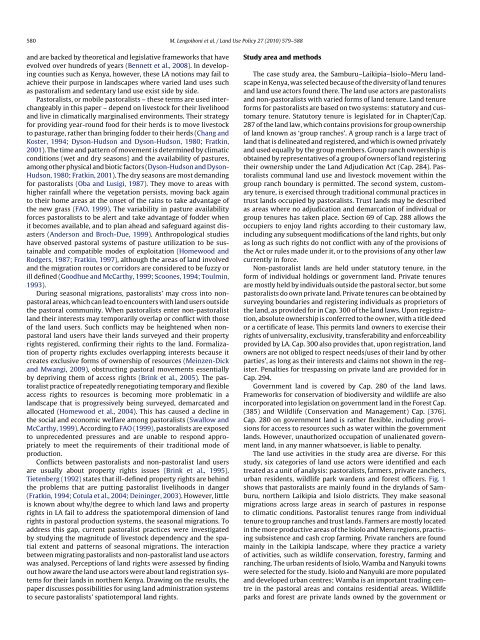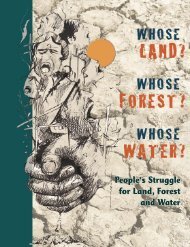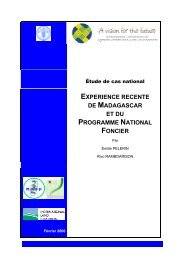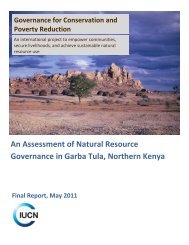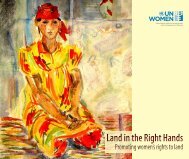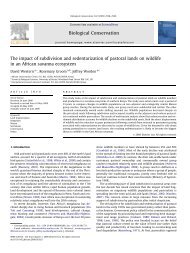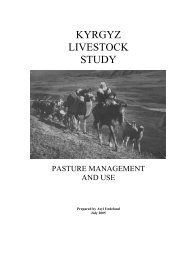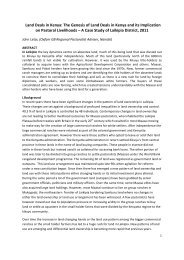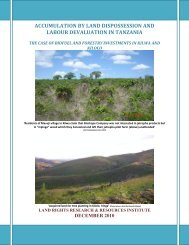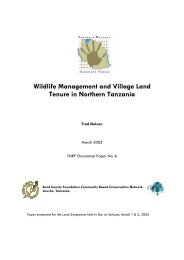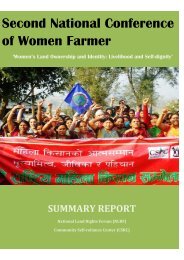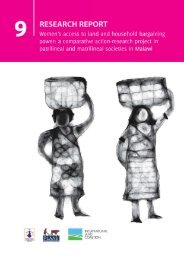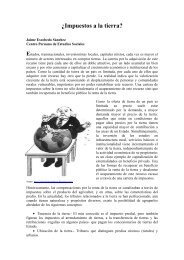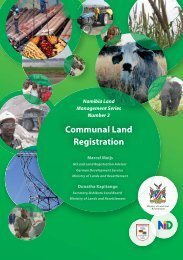Land Use Policy Pastoralism within land administration ... - Land Portal
Land Use Policy Pastoralism within land administration ... - Land Portal
Land Use Policy Pastoralism within land administration ... - Land Portal
You also want an ePaper? Increase the reach of your titles
YUMPU automatically turns print PDFs into web optimized ePapers that Google loves.
580 M. Lengoiboni et al. / <strong>Land</strong> <strong>Use</strong> <strong>Policy</strong> 27 (2010) 579–588<br />
and are backed by theoretical and legislative frameworks that have<br />
evolved over hundreds of years (Bennett et al., 2008). In developing<br />
counties such as Kenya, however, these LA notions may fail to<br />
achieve their purpose in <strong>land</strong>scapes where varied <strong>land</strong> uses such<br />
as pastoralism and sedentary <strong>land</strong> use exist side by side.<br />
Pastoralists, or mobile pastoralists – these terms are used interchangeably<br />
in this paper – depend on livestock for their livelihood<br />
and live in climatically marginalised environments. Their strategy<br />
for providing year-round food for their herds is to move livestock<br />
to pasturage, rather than bringing fodder to their herds (Chang and<br />
Koster, 1994; Dyson-Hudson and Dyson-Hudson, 1980; Fratkin,<br />
2001). The time and pattern of movement is determined by climatic<br />
conditions (wet and dry seasons) and the availability of pastures,<br />
among other physical and biotic factors (Dyson-Hudson and Dyson-<br />
Hudson, 1980; Fratkin, 2001). The dry seasons are most demanding<br />
for pastoralists (Oba and Lusigi, 1987). They move to areas with<br />
higher rainfall where the vegetation persists, moving back again<br />
to their home areas at the onset of the rains to take advantage of<br />
the new grass (FAO, 1999). The variability in pasture availability<br />
forces pastoralists to be alert and take advantage of fodder when<br />
it becomes available, and to plan ahead and safeguard against disasters<br />
(Anderson and Broch-Due, 1999). Anthropological studies<br />
have observed pastoral systems of pasture utilization to be sustainable<br />
and compatible modes of exploitation (Homewood and<br />
Rodgers, 1987; Fratkin, 1997), although the areas of <strong>land</strong> involved<br />
and the migration routes or corridors are considered to be fuzzy or<br />
ill defined (Goodhue and McCarthy, 1999; Scoones, 1994; Toulmin,<br />
1993).<br />
During seasonal migrations, pastoralists’ may cross into nonpastoral<br />
areas, which can lead to encounters with <strong>land</strong> users outside<br />
the pastoral community. When pastoralists enter non-pastoralist<br />
<strong>land</strong> their interests may temporarily overlap or conflict with those<br />
of the <strong>land</strong> users. Such conflicts may be heightened when nonpastoral<br />
<strong>land</strong> users have their <strong>land</strong>s surveyed and their property<br />
rights registered, confirming their rights to the <strong>land</strong>. Formalization<br />
of property rights excludes overlapping interests because it<br />
creates exclusive forms of ownership of resources (Meinzen-Dick<br />
and Mwangi, 2009), obstructing pastoral movements essentially<br />
by depriving them of access rights (Brink et al., 2005). The pastoralist<br />
practice of repeatedly renegotiating temporary and flexible<br />
access rights to resources is becoming more problematic in a<br />
<strong>land</strong>scape that is progressively being surveyed, demarcated and<br />
allocated (Homewood et al., 2004). This has caused a decline in<br />
the social and economic welfare among pastoralists (Swallow and<br />
McCarthy, 1999). According to FAO (1999), pastoralists are exposed<br />
to unprecedented pressures and are unable to respond appropriately<br />
to meet the requirements of their traditional mode of<br />
production.<br />
Conflicts between pastoralists and non-pastoralist <strong>land</strong> users<br />
are usually about property rights issues (Brink et al., 1995).<br />
Tietenberg (1992) states that ill-defined property rights are behind<br />
the problems that are putting pastoralist livelihoods in danger<br />
(Fratkin, 1994; Cotula et al., 2004; Deininger, 2003). However, little<br />
is known about why/the degree to which <strong>land</strong> laws and property<br />
rights in LA fail to address the spatiotemporal dimension of <strong>land</strong><br />
rights in pastoral production systems, the seasonal migrations. To<br />
address this gap, current pastoralist practices were investigated<br />
by studying the magnitude of livestock dependency and the spatial<br />
extent and patterns of seasonal migrations. The interaction<br />
between migrating pastoralists and non-pastoralist <strong>land</strong> use actors<br />
was analysed. Perceptions of <strong>land</strong> rights were assessed by finding<br />
out how aware the <strong>land</strong> use actors were about <strong>land</strong> registration systems<br />
for their <strong>land</strong>s in northern Kenya. Drawing on the results, the<br />
paper discusses possibilities for using <strong>land</strong> <strong>administration</strong> systems<br />
to secure pastoralists’ spatiotemporal <strong>land</strong> rights.<br />
Study area and methods<br />
The case study area, the Samburu–Laikipia–Isiolo–Meru <strong>land</strong>scape<br />
in Kenya, was selected because of the diversity of <strong>land</strong> tenures<br />
and <strong>land</strong> use actors found there. The <strong>land</strong> use actors are pastoralists<br />
and non-pastoralists with varied forms of <strong>land</strong> tenure. <strong>Land</strong> tenure<br />
forms for pastoralists are based on two systems: statutory and customary<br />
tenure. Statutory tenure is legislated for in Chapter/Cap.<br />
287 of the <strong>land</strong> law, which contains provisions for group ownership<br />
of <strong>land</strong> known as ‘group ranches’. A group ranch is a large tract of<br />
<strong>land</strong> that is delineated and registered, and which is owned privately<br />
and used equally by the group members. Group ranch ownership is<br />
obtained by representatives of a group of owners of <strong>land</strong> registering<br />
their ownership under the <strong>Land</strong> Adjudication Act (Cap. 284). Pastoralists<br />
communal <strong>land</strong> use and livestock movement <strong>within</strong> the<br />
group ranch boundary is permitted. The second system, customary<br />
tenure, is exercised through traditional communal practices in<br />
trust <strong>land</strong>s occupied by pastoralists. Trust <strong>land</strong>s may be described<br />
as areas where no adjudication and demarcation of individual or<br />
group tenures has taken place. Section 69 of Cap. 288 allows the<br />
occupiers to enjoy <strong>land</strong> rights according to their customary law,<br />
including any subsequent modifications of the <strong>land</strong> rights, but only<br />
as long as such rights do not conflict with any of the provisions of<br />
the Act or rules made under it, or to the provisions of any other law<br />
currently in force.<br />
Non-pastoralist <strong>land</strong>s are held under statutory tenure, in the<br />
form of individual holdings or government <strong>land</strong>. Private tenures<br />
are mostly held by individuals outside the pastoral sector, but some<br />
pastoralists do own private <strong>land</strong>. Private tenures can be obtained by<br />
surveying boundaries and registering individuals as proprietors of<br />
the <strong>land</strong>, as provided for in Cap. 300 of the <strong>land</strong> laws. Upon registration,<br />
absolute ownership is conferred to the owner, with a title deed<br />
or a certificate of lease. This permits <strong>land</strong> owners to exercise their<br />
rights of universality, exclusivity, transferability and enforceability<br />
provided by LA. Cap. 300 also provides that, upon registration, <strong>land</strong><br />
owners are not obliged to respect needs/uses of their <strong>land</strong> by other<br />
parties’, as long as their interests and claims not shown in the register.<br />
Penalties for trespassing on private <strong>land</strong> are provided for in<br />
Cap. 294.<br />
Government <strong>land</strong> is covered by Cap. 280 of the <strong>land</strong> laws.<br />
Frameworks for conservation of biodiversity and wildlife are also<br />
incorporated into legislation on government <strong>land</strong> in the Forest Cap.<br />
(385) and Wildlife (Conservation and Management) Cap. (376).<br />
Cap. 280 on government <strong>land</strong> is rather flexible, including provisions<br />
for access to resources such as water <strong>within</strong> the government<br />
<strong>land</strong>s. However, unauthorized occupation of unalienated government<br />
<strong>land</strong>, in any manner whatsoever, is liable to penalty.<br />
The <strong>land</strong> use activities in the study area are diverse. For this<br />
study, six categories of <strong>land</strong> use actors were identified and each<br />
treated as a unit of analysis: pastoralists, farmers, private ranchers,<br />
urban residents, wildlife park wardens and forest officers. Fig. 1<br />
shows that pastoralists are mainly found in the dry<strong>land</strong>s of Samburu,<br />
northern Laikipia and Isiolo districts. They make seasonal<br />
migrations across large areas in search of pastures in response<br />
to climatic conditions. Pastoralist tenures range from individual<br />
tenure to group ranches and trust <strong>land</strong>s. Farmers are mostly located<br />
in the more productive areas of the Isiolo and Meru regions, practising<br />
subsistence and cash crop farming. Private ranchers are found<br />
mainly in the Laikipia <strong>land</strong>scape, where they practice a variety<br />
of activities, such as wildlife conservation, forestry, farming and<br />
ranching. The urban residents of Isiolo, Wamba and Nanyuki towns<br />
were selected for the study. Isiolo and Nanyuki are more populated<br />
and developed urban centres; Wamba is an important trading centre<br />
in the pastoral areas and contains residential areas. Wildlife<br />
parks and forest are private <strong>land</strong>s owned by the government or


